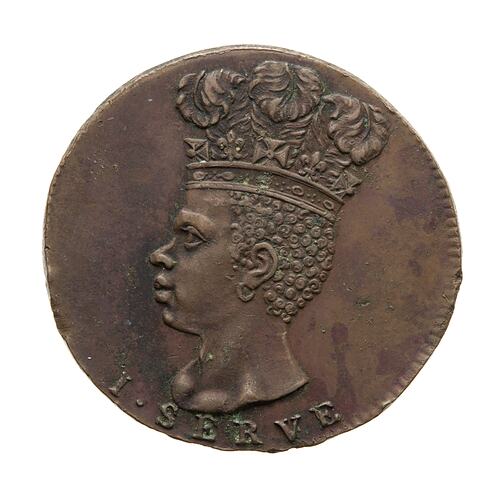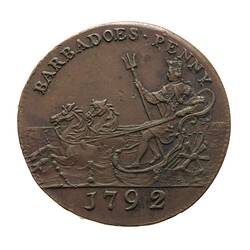Summary
1 Penny token, Issued by, Sir Philip Gibbs, Barbados, 1792.
Gibbs Plantation Token
Minted at Milton, J. (probably using Royal Mint press) struck on 25 July 1792
Obverse Description
The head of a slave facing left, wearing a coronet and three feather plume; below, I SERVE; artist's initial, M, incuse on neck trucation.
Reverse Description
King George III (as Neptune) seated in a chariot drawn to left by a pair of hippocampi; above, BARBADOES . PENNY ; in exergue, 1792
Edge Description
Plain
Significance
In 1788 the Gibbs Plantation successfully circulated a token coinage featuring a slave and a pineapple throughout Barbados. A second design was sought in 1792 based on the Seal of the island, King George III as Neptune being drawn across the sea in a bega of hippocampi. The dies were engraved by J. Milton of the Royal Mint, London who seems to have supervised the striking on 24 July 1792. The seal was granted by King Charles II on 3 June 1663.
More Information
-
Collecting Areas
-
Acquisition Information
Donation from Mr Robert Edwards - Museum of Victoria, 02 Oct 1987
-
Date Issued
1792 AD
-
Issued By
-
Mint
-
Artist
-
Previous Collection
Mr Henry S. Smith
Previous Collection originally recorded as Henry J. Smith, South Australia, circa 1850 - the middle initial of which is assumeed to be a mistake. -
Denomination
-
Series
-
Material
Copper
-
Axis
12
-
Classification
-
Category
-
Discipline
-
Type of item
-
Dimensions
32 mm (Outside Diameter), 12.364 g (Weight)
-
Shape
Off round
-
References
Pridmore 3.14 Remick C1 Hocking 4113
[Book] Hocking, William J. 1906. Catalogue of the Coins, Tokens, Medals, Dies and Seals in the Museum of the Royal Mint.
[Book] Pridmore, Fred. 1965. The Coins of the British Commonwealth of Nations, Part 3, West Indies.
[Book] Remick, Jerome. 1971. British Commonwealth Coins.
-
Keywords
Hippocampi, Mythical Animals, Slavery, British Empire Coins, British Commonwealth and Empire Coins


